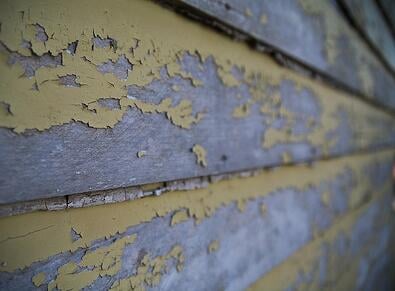What Your Neighbors Wish You Knew About Your Peeling Paint Problem
Jeremy Holderness A good exterior paint job with a high quality exterior paint should last you several years. One way you can tell when it's time to re-paint your home is when the paint is peeling off of it. (I guess that's kind of a no-brainer.)
A good exterior paint job with a high quality exterior paint should last you several years. One way you can tell when it's time to re-paint your home is when the paint is peeling off of it. (I guess that's kind of a no-brainer.)
Hopefully there will be earlier signs telling you that your paint job is nearing the end of its useful life before it gets to that point. But if this situation has presented itself sooner than you would've expected, it is important to recognize that not only is peeling paint an eyesore, it opens up a Pandora's box of problems that are inevitable once a bare substrate no longer has the benefit of its protective coating -- leaving it exposed to nature's harsh elements.
Exterior house paint not only makes your home stand out by highlighting it's natural beauty and architecture, it serves as a sacrificial barrier that prevents surface deterioration, water infiltration, mold & mildew growth, infestations from certain types of pests, etc, etc.
Once peeling has begun to occur, especially widespread peeling, care must be taken to diagnose the cause, and proper steps taken to remedy the problem. In most cases, simply scraping the loose stuff and brushing some new paint on the surface will not suffice...at least not in the long term.
Paint can peel off of a number of different types of siding. We've written articles addressing the correct way to paint masonry surfaces, as well as painting aluminum siding. We've also discussed exterior painting problems, along with when you should use a primer to help your paint stick better. But as the image above would suggest, this week's post will be devoted to tackling the topic of peeling paint on wood clapboard siding, and how to fix it.
Is Your House Really Peeling?
When people see exterior paint failing on their home they generally refer to it as peeling paint, but that's not necessarily an accurate description of what's truly going on with the coating. It may in fact be a number of other issues, and properly diagnosing the problem can not only tell us why it's failing, but it can also tell us how to correct it.
For instance, paint blistering is a similar issue -- being that the film is also coming loose from the surface -- but it is generally caused by the coating having been exposed to moisture or excessive heat before it was completely dry, or having been applied over top of a surface contaminate like grease.
Alligatoring is another issue that is commonly seen on older houses. It points to an oil-based paint having been used. Oil-based paints are not nearly as flexible as their commonly-used cousin, acrylic latex. As the oil coating ages it often will split or crack because it can’t expand and contract with the surface beneath. Sometimes this condition happens quickly when new oil-based paint is applied over a flexible coating like an acrylic.
Although these problems may be similar in nature they will sometimes require a different approach to achieve the same end result.
What Causes Paint To Peel?
When paint peels it is always telling us that there is a loss of adhesion somewhere...but the questions is 'where?' The first and best place to start your investigation is by picking up a paint chip from the ground or peeling off a loose piece from the house and looking closely at the back of the sample.
Intercoat Paint Failure
If when you look at the back of the sample you can see that one or more layers of paint have come loose from other layer(s) of paint, leaving a paint film still attached to the siding, you have what is known as intercoat paint failure. Inadequate surface preparation is always to blame when one coating doesn't stick to the other and eventually lets go. If you observe the 'Big Rule of 3' when it comes to preparing any surface for paint -- as in Clean, Dry, & Dull -- this situation can usually be avoided altogether.
Although, to be fair, it can be difficult at times to get acrylic paint to stick well to old oil-based paint without extensive sanding of the surface and even the use of a primer. You can perform a test on a coating to tell if it's oil or latex by moistening the corner of a rag with some denatured alcohol and rubbing it vigorously along the surface of the paint film. If you can look at your rag and see that the solvent is beginning to wipe away the coating then it is not an oil-based paint, as the alcohol solvent will break-down a latex coating but not an oil.
If you've identified your paint as an oil, performed the extra surface prep work, but are still in doubt, you can always apply a small test sample of your new paint and then perform an adhesion test (as described in this blog post) on it to be certain it is going to stick.
Failure Down To Bare Substrate
Intercoat failure is pretty straight-forward to diagnose, but coating failure down to bare substrate can be a bit tricky to get to the bottom of.
Lack of Surface Prep - Most often, as with nearly all paint failures, it is due to insufficient preparation of the surface prior to painting. Wood siding needs to be cleaned with a pre-paint cleaner, allowed to dry, scraped of any loose or peeling paint, lightly sanded, wiped clean of dust, and the bare spots primed with a wood primer before paint touches it.
When sanding make sure to not only feather-sand the edges of the peeled paint, but also lightly sand the surface of any bare wood. New wood can develop a mill glaze or a sheen that will interfere with adhesion and must be sanded off. As well, the surface of older bare wood that is exposed to weather over time will slowly begin to degrade and turn grey. This needs to be sanded down until a sound, paintable surface can be achieved.
On bare spots where the wood is old and weathered I would recommend the use of a slow-drying oil base wood primer. Because of their slow drying time, these long oils tend to penetrate deeper into the wood, promoting better adhesion to the surface.
Old Paint - A new coat of paint will only stick as well as the old coat(s) of paint its been applied to. The bottom layer of paint that's directly touching the wood can only take the stress of so many new layers of paint on top of it. When it fails, as it eventually will, it will take the subsequent layers with it when it peels off. This process is made to happen sooner any time a new coat of paint is applied without all of the partially loose paint first being completely scraped off.
So be sure to thoroughly scrape any loose film before you move to the next step. If when you're scraping you notice that the film continues to peel no matter how much you work on it, try using a binding primer that's formulated to help seal down the edges of perpetually peeling paint. Zinsser makes a product that I like very much for this application called Peel Stop.
Moisture - Finally, the other main culprit of peeling is moisture getting behind the coating. It doesn't matter whether it's coming from inside the wall cavity; from a leaking gutter, roof, or window; or from landscaping plants that are growing too close to the house and causing moisture to permeate the paint film. When moisture gets behind the paint film it has to get out, and as it's making its escape it often takes the paint off with it.
Pay close attention to see if there are any wood fibers present on the back of the peeling paint sample. Also check peeling samples on other areas of the house to see if you find them there as well. Loose wood fibers can be a sign of wood delamination. This is usually, but not always, caused by moisture. Wood delamination should always be further inspected by a reputable building/remodeling contractor to find and cure the cause before you do any painting.
Caulking - Many painters will use a cheap "painter's caulk" on your house, and even then many of them don't apply it correctly. Incorrectly applied caulking, and cheap caulking that cracks, shrinks and pulls away from the wood will create entry points for water to get behind the paint film and even behind the siding itself.
Caulking that's in bad shape needs to be removed and replaced with a minimum of a higher-quality acrylic latex caulking.
A proper diagnosis of your home's peeling paint problem is essential to curing its ills. And choosing the right paint, in combination with the right painting practices will give you a home that will be the showpiece of your neighborhood for many years to come.
If you're in the Greater Pittsburgh or Western Pennsylvania areas and would like some assistance diagnosing your home's peeling paint problem please give us a call at 724-898-2446, visit our 'Contact Us' page, or click on the button below to have us contact you.
photo by: wonderferret / CC BY 4.0








